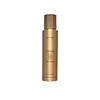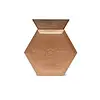What's inside
What's inside
 Key Ingredients
Key Ingredients

No key ingredients
 Benefits
Benefits

 Concerns
Concerns

 Ingredients Side-by-side
Ingredients Side-by-side

Water
Skin ConditioningSodium C14-16 Olefin Sulfonate
CleansingCocamidopropyl Hydroxysultaine
CleansingCoco-Glucoside
CleansingSalvia Hispanica Seed Extract
EmollientPPG-2 Hydroxyethyl Coco/Isostearamide
Panthenol
Skin ConditioningCarthamus Tinctorius Seed Oil
MaskingHydrolyzed Carrot Protein/Hydrolyzed Kale Protein/Hydrolyzed Lemon Protein Extract
Helianthus Annuus Seed Extract
Skin ConditioningAloe Barbadensis Leaf Juice
Skin ConditioningSodium PCA
HumectantGlycerin
HumectantCocamidopropyl Pg-Dimonium Chloride
Guar Hydroxypropyltrimonium Chloride
Skin ConditioningGlycol Stearate
EmollientCetyl Alcohol
EmollientGlycol Distearate
EmollientCarbomer
Emulsion StabilisingCetrimonium Chloride
AntimicrobialStearamidopropyl Dimethylamine
EmulsifyingPhenoxyethanol
PreservativeSodium Benzoate
MaskingCitric Acid
BufferingSodium Chloride
MaskingSodium Hydroxide
BufferingParfum
MaskingWater, Sodium C14-16 Olefin Sulfonate, Cocamidopropyl Hydroxysultaine, Coco-Glucoside, Salvia Hispanica Seed Extract, PPG-2 Hydroxyethyl Coco/Isostearamide, Panthenol, Carthamus Tinctorius Seed Oil, Hydrolyzed Carrot Protein/Hydrolyzed Kale Protein/Hydrolyzed Lemon Protein Extract, Helianthus Annuus Seed Extract, Aloe Barbadensis Leaf Juice, Sodium PCA, Glycerin, Cocamidopropyl Pg-Dimonium Chloride, Guar Hydroxypropyltrimonium Chloride, Glycol Stearate, Cetyl Alcohol, Glycol Distearate, Carbomer, Cetrimonium Chloride, Stearamidopropyl Dimethylamine, Phenoxyethanol, Sodium Benzoate, Citric Acid, Sodium Chloride, Sodium Hydroxide, Parfum
Ingredients Explained
These ingredients are found in both products.
Ingredients higher up in an ingredient list are typically present in a larger amount.
Parfum is a catch-all term for an ingredient or more that is used to give a scent to products.
Also called "fragrance", this ingredient can be a blend of hundreds of chemicals or plant oils. This means every product with "fragrance" or "parfum" in the ingredients list is a different mixture.
For instance, Habanolide is a proprietary trade name for a specific aroma chemical. When used as a fragrance ingredient in cosmetics, most aroma chemicals fall under the broad labeling category of “FRAGRANCE” or “PARFUM” according to EU and US regulations.
The term 'parfum' or 'fragrance' is not regulated in many countries. In many cases, it is up to the brand to define this term.
For instance, many brands choose to label themselves as "fragrance-free" because they are not using synthetic fragrances. However, their products may still contain ingredients such as essential oils that are considered a fragrance by INCI standards.
One example is Calendula flower extract. Calendula is an essential oil that still imparts a scent or 'fragrance'.
Depending on the blend, the ingredients in the mixture can cause allergies and sensitivities on the skin. Some ingredients that are known EU allergens include linalool and citronellol.
Parfum can also be used to mask or cover an unpleasant scent.
The bottom line is: not all fragrances/parfum/ingredients are created equally. If you are worried about fragrances, we recommend taking a closer look at an ingredient. And of course, we always recommend speaking with a professional.
Learn more about Parfum